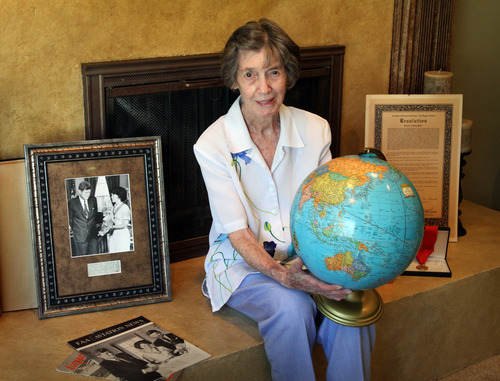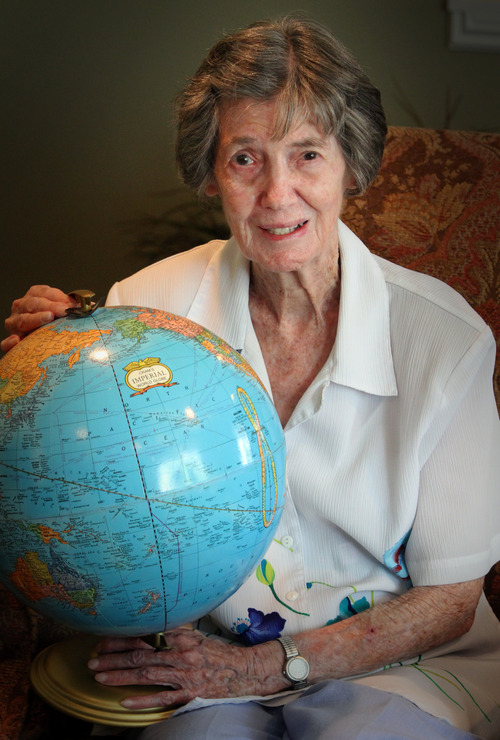This is an archived article that was published on sltrib.com in 2013, and information in the article may be outdated. It is provided only for personal research purposes and may not be reprinted.
Bountiful • While most history buffs know the story of Amelia Earhart becoming the first woman to fly across the Atlantic Ocean in 1932 and about her mysterious disappearance on a around-the-world flight in 1937, only a few have discovered the story of the first female to fly solo across the Pacific Ocean.
That woman's name is Betty Miller, who now resides in Bountiful and who learned to fly at Wendover's historic airfield in the early 1950s. Unlike Earhart, who was accompanied by navigator Fred Noonan on her historic flights, Miller flew solo, unless you count her lucky troll doll named Dammit.
Miller's relatives, Judy Jackson and Patty Jeys, will be gathering with friends in Centerville on Sunday to celebrate the 50th anniversary of the 7,415-mile flight.
Miller left Oakland, Calif., in a Piper Apache on April 25, 1963, making in stops in Hawaii, Canton Island, Fiji and New Caledonia. When she landed in Brisbane, Australia, on May 13, Miller climbed out of the plane wearing a cotton dress and high heels to the cheers of a large crowd. The moment would be recorded by an Associated Press photographer.
The photo would be the first transmitted by a new wire-photo process. Miller would be featured on the covers of magazines, the front pages of newspapers and given high aviation honors by Presidents John F. Kennedy and Lyndon B. Johnson.
Now 87 and recovering from a broken hip, Miller remains humble about her accomplishment. The aviator says she simply had a job to do. She needed to deliver a plane to a buyer in Australia.
In those days, small planes didn't have the fuel capacity to fly overseas. They were taken apart, shipped and then reassembled at their destination.
William Piper, who manufactured Piper airplanes, devised the plan to allow Miller to fly the small plane to Australia. Max Conrad, a record-breaking long-distance pilot, helped design the extra gas tanks required for the long flight. The plane needed to carry so much fuel that some airports would not allow it to land.
"I didn't do it for the purpose of setting a record, though that was a nice part of it," said Miller, who operated a Santa Monica, Calif., flight school with her husband. "People wanted the airplane and I was willing to deliver it."
She used her training as a radio specialist to navigate, trying to check in with ships or ground stations every half hour whenever possible. On the flight to Hawaii, she flew 20 hours straight. Miller dealt with equipment problems and a hurricane.
Was she frightened?
"If you've got a brain and it works, you think about all these things," she said. "You get thoughts, but you think about your own skills and education."
"There was definitely danger involved," said Kelli Money Huff, who befriended Miller after serving as the pilot's art instructor in Ocala, Fla., 15 years ago. "But she was a skilled pilot. She paid attention and worked around it."
Huff, who flew in from Florida to attend Sunday's ceremony, has worked hard to preserve Miller's story. She has pages of hand-written notes from conversations and has preserved newspapers, magazines, photos, the original map of the flight and the FAA gold medal for exceptional service that was presented by President Kennedy.
"What you discover is the relative lack of communication ability available during that 1963 flight compared to now," said Huff. "Now we would know exactly where you are at. But for long periods of time due to radio issues, you couldn't communicate."
Miller remembers Wendover in the early 1950s as a desolate place where there was so little to do that she rented a piano and had it trucked to her apartment from Salt Lake. She had moved to the small Utah town from her home in California.
The Pacific flight was a small part of her aviation pioneering. Working with husband Chuck Miller at a flight school in Santa Monica, Calif., she was an instructor, dispatcher, bookkeeper and maintenance scheduler. The pair helped train more than 4,000 new pilots, including movie stars such as Jimmy Stewart.
She helped set physical standards for women astronauts that are still used today, was the first woman to solo a Hughes model 269A helicopter and only the 38th woman to earn a helicopter license, was the chairperson of the FAA's Women's Advisory Committee on Aviation and served as a flight instructor in Hawaii and Puerto Rico.
Miller participated as a member of the U.S. Helicopter Team in the second World Helicopter Championships held in England in 1973 and participated in the original Powder Puff Derby All Woman Transcontinental Air Races 11 times. She is a member of the Whirly Girls female helicopter pilots and a past member of the Ninety-Nines, a women's pilot association founded by Earhart.
She lives with her parrot Paco, who often says "Roger That!" and has flown with Miller. Last August, at 86, she piloted a Cessna out of Salt Lake Airport No. 2 with the plane's owner, Randy Mitchell.
Though she should be one of the most famous pilots of all time, Miller remains humble and quiet. It takes some prodding to get her to talk about her many accomplishments, though family members and friends such as Huff continue to document her story.
Twitter @tribtomwharton —
Betty Miller timeline
1950 • Went to Wendover Airfield to work for the Civil Aeronautics Administration, precursor to the Federal Aviation Administration. She met her husband Chuck Miller there in 1951.
1952 • Qualified for a pilot's license.
1953 • Earned her trainer instructor's license.
1954 • Started Santa Monica Flyers flight and ground school in 1954 in California with her husband. She worked as an instructor, dispatcher, bookkeeper and maintenance scheduler. The business started with 23 students and graduated more than 4,000 new pilots.
1961 • Set physical standards for women astronauts in 1961 at the Lovelace Clinic in Albuquerque, N.M. She participated in physical tests that are the basis for present day testing.
1961 • First woman to solo a Hughes Model 269A helicopter.
1963 • Became first woman to fly solo across the Pacific Ocean, taking a Piper Apache plane from Oakland, Calif., to Brisbane, Australia. President John F. Kennedy presented her with the Federal Aviation Administration's Gold Medal for Exceptional Service in honor of the fight and was recognized by President Lyndon Johnson as Aviatrix of the Year with the presentation of the Harmon International Trophy.
1968 • FAA Women's Advisory Committee chairwoman.
1969 to 1976 • Worked as flight instructor for Cessna Pilot Center in Honolulu, Hawaii.
1973 • Participated in the Second World Helicopter Championships in England.







